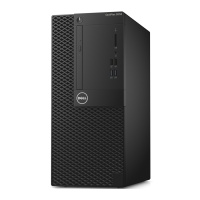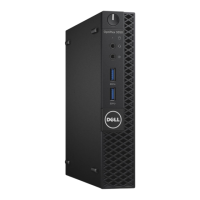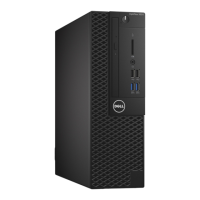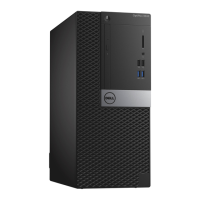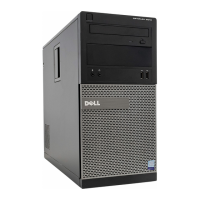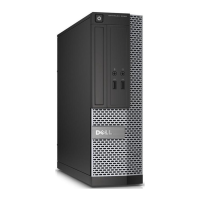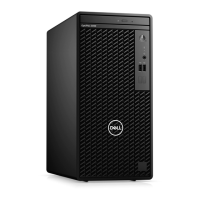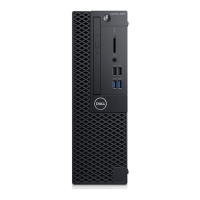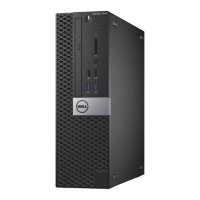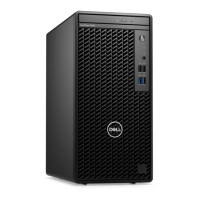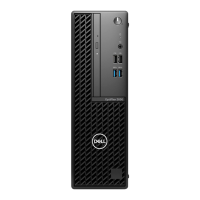Do you have a question about the Dell OptiPlex 3050 and is the answer not in the manual?
Essential safety guidelines for handling the computer and preventing damage or injury.
Steps to prepare the computer before performing internal maintenance or component replacement.
Procedures for safely shutting down the computer in Windows 10 and Windows 7.
Steps to reconnect devices and verify functionality after internal work.
General notes and precautions regarding computer usage and environmental factors.
Instructions for removing and installing the computer's stand or easel.
Procedures for removing and installing the optical drive.
Steps to remove and replace the computer's back cover.
Procedures for removing and installing the system's hard drive.
Steps for removing and installing RAM modules.
Guide for removing and installing the SSD card.
Instructions for removing and installing the CPU heat sink.
Procedures for removing and installing the system fan (35W and 65W).
Detailed steps for removing and installing the CPU.
Instructions for removing and installing the main system board.
Procedures for removing and installing the computer's chassis frame.
Steps for removing and installing the display panel assembly.
Guide for removing and installing the computer's camera module.
Overview of Intel 6th and 7th generation processors used in the system.
Information on identifying the system's chipset in Device Manager.
Guidance on verifying and installing Intel HD Graphics drivers.
Information on supported HDD and PCIe SSD configurations.
Explanation of Universal Serial Bus (USB) technology and its evolution.
Details about the computer's RAM, including DDR4 specifications.
Introduction to the system's BIOS and its functions.
How to access and use the one-time boot menu.
Overview of configurable options within the system setup utility.
Key processor, cache, and chipset specifications.
Details on memory type, capacity, connectors, and speed.
Information about integrated video controllers and external display support.
Specifications for the audio controller, speakers, and microphone.
Details on screen type, resolution, refresh rate, and dimensions.
Information on power type, voltage, input current, and output voltage.
Dimensions and weight of the computer with and without the stand.
Operating and storage conditions for temperature, humidity, vibration, and shock.
Guide to performing hardware diagnostics using the ePSA tool.
Instructions for performing an LCD built-in self-test to diagnose display issues.
Essential safety guidelines for handling the computer and preventing damage or injury.
Steps to prepare the computer before performing internal maintenance or component replacement.
Procedures for safely shutting down the computer in Windows 10 and Windows 7.
Steps to reconnect devices and verify functionality after internal work.
General notes and precautions regarding computer usage and environmental factors.
Instructions for removing and installing the computer's stand or easel.
Procedures for removing and installing the optical drive.
Steps to remove and replace the computer's back cover.
Procedures for removing and installing the system's hard drive.
Steps for removing and installing RAM modules.
Guide for removing and installing the SSD card.
Instructions for removing and installing the CPU heat sink.
Procedures for removing and installing the system fan (35W and 65W).
Detailed steps for removing and installing the CPU.
Instructions for removing and installing the main system board.
Procedures for removing and installing the computer's chassis frame.
Steps for removing and installing the display panel assembly.
Guide for removing and installing the computer's camera module.
Overview of Intel 6th and 7th generation processors used in the system.
Information on identifying the system's chipset in Device Manager.
Guidance on verifying and installing Intel HD Graphics drivers.
Information on supported HDD and PCIe SSD configurations.
Explanation of Universal Serial Bus (USB) technology and its evolution.
Details about the computer's RAM, including DDR4 specifications.
Introduction to the system's BIOS and its functions.
How to access and use the one-time boot menu.
Overview of configurable options within the system setup utility.
Key processor, cache, and chipset specifications.
Details on memory type, capacity, connectors, and speed.
Information about integrated video controllers and external display support.
Specifications for the audio controller, speakers, and microphone.
Details on screen type, resolution, refresh rate, and dimensions.
Information on power type, voltage, input current, and output voltage.
Dimensions and weight of the computer with and without the stand.
Operating and storage conditions for temperature, humidity, vibration, and shock.
Guide to performing hardware diagnostics using the ePSA tool.
Instructions for performing an LCD built-in self-test to diagnose display issues.
| Bus type | DMI3 |
|---|---|
| Stepping | S0 |
| Tjunction | 100 °C |
| Processor cache | 3 MB |
| Processor cores | 2 |
| Processor model | i3-7100 |
| System bus rate | 8 GT/s |
| Processor family | Intel® Core™ i3 |
| Processor socket | LGA 1151 (Socket H4) |
| Processor threads | 4 |
| Processor codename | Kaby Lake |
| Processor frequency | 3.9 GHz |
| Processor cache type | Smart Cache |
| Processor lithography | 14 nm |
| Processor manufacturer | Intel |
| PCI Express slots version | 3.0 |
| Processor operating modes | 64-bit |
| ECC supported by processor | No |
| PCI Express configurations | 1x16, 1x8+2x4, 2x8 |
| Thermal Design Power (TDP) | 51 W |
| Number of processors installed | 1 |
| Maximum number of PCI Express lanes | 16 |
| Memory types supported by processor | DDR3L-SDRAM, DDR4-SDRAM |
| Memory clock speeds supported by processor | 1333, 1600, 2133, 2400 MHz |
| Maximum internal memory supported by processor | 64 GB |
| Chassis type | SFF |
| Product color | Black |
| Cable lock slot | Yes |
| Placement supported | Horizontal/Vertical |
| Audio chip | Realtek ALC3234 |
| Product type | PC |
| Market positioning | Business |
| Password protection type | BIOS, Supervisor, User |
| Compatible processor series | Intel Celeron, Intel Pentium |
| Memory slots | 2x DIMM |
| Internal memory | 4 GB |
| Memory channels | Dual-channel |
| Memory clock speed | 2400 MHz |
| Internal memory type | DDR4-SDRAM |
| Maximum internal memory | 32 GB |
| Memory layout (slots x size) | 1 x 4 GB |
| SSD capacity | The Solid State Drive's storage capacity in Gigabytes. |
| Storage media | SSD |
| Optical drive type | DVD±RW |
| Card reader integrated | - |
| Total storage capacity | 128 GB |
| On-board graphics card ID | 0x5912 |
| Discrete graphics card model | Not available |
| On-board graphics card model | Intel® HD Graphics 630 |
| On-board graphics card OpenGL version | 4.4 |
| On-board graphics card base frequency | 350 MHz |
| On-board graphics card DirectX version | 12.0 |
| On-board graphics card dynamic frequency (max) | 1100 MHz |
| Number of displays supported (on-board graphics) | 3 |
| Trial software | Microsoft Office |
| Operating system language | Multilingual |
| Cabling technology | 10/100/1000Base-T(X) |
| Ethernet LAN data rates | 10, 100, 1000 Mbit/s |
| Power supply | 180 W |
| Power supply input voltage | 90 - 264 V |
| Power supply input frequency | 47/63 Hz |
| HDMI version | 1.4 |
| USB 2.0 ports quantity | USB 2.0 ports have a data transmission speed of 480 Mbps, and are backwards compatible with USB 1.1 ports. You can connect all kinds of peripheral devices to them. |
| USB 3.2 Gen 1 (3.1 Gen 1) Type-C ports quantity | 0 |
| Operating altitude | -15.2 - 3048 m |
| Non-operating altitude | -15.2 - 10668 m |
| Storage temperature (T-T) | -40 - 65 °C |
| Operating temperature (T-T) | 0 - 35 °C |
| Storage relative humidity (H-H) | 5 - 95 % |
| Operating relative humidity (H-H) | 10 - 90 % |
| Cables included | AC |
| Scalability | 1S |
| Processor code | SR35C |
| Processor ARK ID | 97455 |
| Processor package size | 37.5 x 37.5 mm |
| Supported instruction sets | AVX 2.0, SSE4.1, SSE4.2 |
| Thermal solution specification | PCG 2015C |
| Intel Identity Protection Technology version | 1.00 |
| Intel Stable Image Platform Program (SIPP) version | 0.00 |
| Depth | 292 mm |
|---|---|
| Width | 92.7 mm |
| Height | 290 mm |
| Weight | 5140 g |
